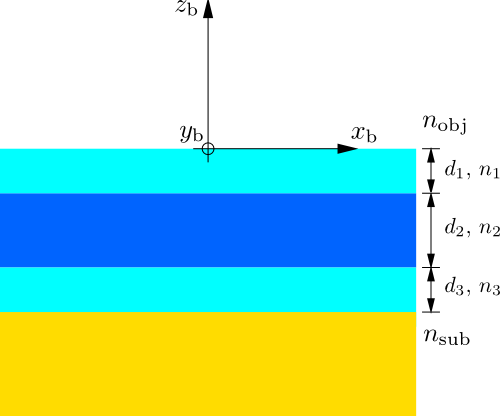Stratification¶
| Type: | section |
|---|---|
| Appearance: | optional |
This section is used to define a stratified blank / substrate. As shown in Figure “Stratified blank”, the blank is equipped with coordinates  . The stratification is normal to the
. The stratification is normal to the  direction which coincides with the optical axis when the blank is not tilted (as set by the parameter Rotation).
direction which coincides with the optical axis when the blank is not tilted (as set by the parameter Rotation).

Stratified blank¶
The refractive index  is a piece-wise constant function of
is a piece-wise constant function of  ,
,

where  is the position of the
is the position of the  interface.
interface.  denotes the thickness of the
denotes the thickness of the  layer. The medium above the blank (
layer. The medium above the blank ( ) has the refractive index
) has the refractive index  of the optical system’s object space whose value is taken from the input Fourier transform data InputFileName. The multilayer stack is followed by an infinite thick substrate of refractive index
of the optical system’s object space whose value is taken from the input Fourier transform data InputFileName. The multilayer stack is followed by an infinite thick substrate of refractive index  .
.
In case of a transmissive blank, the substrate refractive index  is taken from the input file InputFileName as well. This is possible since a Fourier transform file contains information on the illumination. For transmissive blanks the substrate is the half space from which the scatterer is actually illuminated.
is taken from the input file InputFileName as well. This is possible since a Fourier transform file contains information on the illumination. For transmissive blanks the substrate is the half space from which the scatterer is actually illuminated.
For a reflective optical system, the user must specify  .
.